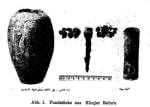The Baghdad Battery
 Figure 1
Figure 1
In 1938, the German artist / archaeologist Wilhelm König published an article about a 5.5-inch jar that, decades later, would take center stage of alternative history speculation. The jar (Figure 1) was found during an excavation in Khujut Rabu, just outside modern Baghdad in Iraq (BBC). M. Jeffrey Oakes explains the controversy created by the find:
[The jar] contained a copper cylinder with its bottom capped by a copper disk and sealed with bitumen or asphalt. An iron rod was suspended from an asphalt stopper at the top of the copper cylinder into the center of the cylinder. The rod showed evidence of having been corroded with an acidic agent such as wine grape juice or vinegar. . . . König theorized that these clay jars were galvanic cells or batteries supposedly used for gilding copper with silver by electroplating. To help support this theory König also found copper vases plated with silver dating from earlier periods.

In the wake of König’s theory, the jar became known as the “Baghdad Battery.” Though primitive in nature, the artifact is often used to establish the outlandish claim that certain civilizations in the ancient Near East developed fantastic modern energy technology (or that aliens taught them how to do so).
 Figure 2
Figure 2
The Baghdad Battery: Was it a Battery?
The Baghdad battery was capable of conducting an electric current. The BBC cited Dr. Marjorie Senechal, a professor of the history of science, as observing, “I don't think anyone can say for sure what they were used for, but they may have been batteries because they do work.”
Replicas of the Baghdad battery (Figure 2), using lemon juice or vinegar as an electrolyte, have produced low voltages, roughly 0.8—2 volts. Creating a strong electrical current would require stringing many of these batteries together. The BBC notes in this regard:
Two main techniques of gilding were used at the time and are still in use today: hammering the precious metal into thin strips using brute force, or mixing it with a mercury base which is then pasted over the article.
These techniques are effective, but wasteful compared with the addition of a small but consistent layer of metal by electro-deposition. The ability to mysteriously electroplate gold or silver on to such objects would not only save precious resources and money, but could also win you important friends at court. . . . Testing this idea in the late seventies, Dr. Arne Eggebrecht, then director of Roemer and Pelizaeus Museum in Hildesheim, connected many replica Baghdad batteries together using grape juice as an electrolyte, and claimed to have deposited a thin layer of silver on to another surface, just one ten thousandth of a millimeter thick.
These experiments are, however, problematic. Other scientists have been unable to reproduce the results and the original experiments were completely undocumented by either notes or photographs.
After careful consideration of the presumed electro-plating process described by König, Eggert has concluded that a modern process (ca. 1840 – contemporary with the discovery) was imposed on the Baghdad jar. He writes:
There are no literary sources or gilded objects which prove ancient knowledge of galvanic gilding. The gilding method of the Baghdad silversmiths is identical to the invention of B.P. 8447, filed in 1840. Therefore, there is no reason to postulate that this process is a relic of ancient knowledge.
There is another explanation for the Baghdad battery as constructed. The jar is of a type widely used to store ancient scrolls. The metal cylinder could have simply been used to wind the scroll. The corrosion of the iron rod within the jar may have been caused by residual grape juice or wine being presented in the jar in a later usage for the jar. Archaeologist Keith Fitzpatrick-Matthews notes:
The asphalt seal is a complete seal, so there would be no way of obtaining any electricity generated within the pot; this suggests that containment was an important consideration in their design. Similar objects from Seleucia were used for storing sacred papyri and this is at least as likely an interpretation as the battery hypothesis.
The Baghdad Battery: Proof of Advanced Energy Technology?
Even if the Baghdad battery was indeed a workable means of storing energy, it is no proof of advanced energy technology in the ancient world. There are some obvious reasons for this.
First, given the low voltage of reconstructions noted above, for the Baghdad battery to be of any meaningful use, the ancient people who fashioned the object would need tens of thousands of them to produce power for a village or, say, to light up a temple. The Baghdad battery is the only such artifact known. One would expect the excavations at the site where the battery was found to produce at least a few dozen batteries if this was indeed an energy source used by the people who lived there, but there is in evidence of this.
Second, the battery was discovered in a Parthian-era (Sassanian) site. This places its age at 250 B.C. – 650 A.D. This is a far cry from the civilizations of ancient Babylon or Akkad, civilizations that ancient alien and alternative history theorists want their viewers and readers to associate with the discovery. The Baghdad batter is more than two millennia removed from those great Mesopotamian civilizations. Consequently, it is not even evidence for weak energy storage for those more ancient civilizations, much less proof of high energy science in great antiquity.
Resources
M. Jeffrey Oakes, “A Brief History of Batteries and Stored Energy,” Neta World (Summer, 2006)
Wilhelm König, “Ein galvanisches Element aus der Partherzeit?” Forschungen und Fortschritte 14:1 (1938): 8-9
Arran Frood, “Riddle of 'Baghdad's batteries',” BBC News (27 February, 2003)
Keith Fitzpatrick-Matthews, “The ‘Batteries of Babylon’,” Bad Archaeology blog (December 2009)
Gerhard Eggert, “On the Origin of a Gilding Method of the Baghdad Silversmiths,” Gold Bulletin 28:1 (1995): 12-16
What is your response?


